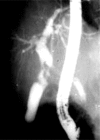Pancreatobiliary and peripancreatobiliary tuberculosis: a rare cause of obstructive jaundice
- PMID: 24482664
- PMCID: PMC3902729
- DOI: 10.5114/aoms.2013.39799
Pancreatobiliary and peripancreatobiliary tuberculosis: a rare cause of obstructive jaundice
Figures




Similar articles
-
A case of endoscopic ultrasound-guided hepaticogastrostomy for obstructive jaundice caused by intraductal papillary mucinous neoplasm-associated pancreatobiliary fistula.Clin J Gastroenterol. 2021 Jun;14(3):893-898. doi: 10.1007/s12328-021-01355-0. Epub 2021 Feb 15. Clin J Gastroenterol. 2021. PMID: 33590462
-
Endosonography for suspected obstructive jaundice with no definite pathology on ultrasonography.J Formos Med Assoc. 2015 Sep;114(9):820-8. doi: 10.1016/j.jfma.2013.09.005. Epub 2013 Sep 30. J Formos Med Assoc. 2015. PMID: 24090635
-
[A case of groove pancreatitis (segmental form) presented with obstructive jaundice associated with pancreatobiliary maljunction].Nihon Shokakibyo Gakkai Zasshi. 2008 Sep;105(9):1390-5. Nihon Shokakibyo Gakkai Zasshi. 2008. PMID: 18772581 Japanese.
-
Role of Endoscopic Procedures in the Diagnosis of IgG4-Related Pancreatobiliary Disease.Chonnam Med J. 2021 Jan;57(1):44-50. doi: 10.4068/cmj.2021.57.1.44. Epub 2021 Jan 25. Chonnam Med J. 2021. PMID: 33537218 Free PMC article. Review.
-
[Recent Updates of Immunoglobulin G4-related Pancreatobiliary Disease].Korean J Gastroenterol. 2020 May 25;75(5):257-263. doi: 10.4166/kjg.2020.75.5.257. Korean J Gastroenterol. 2020. PMID: 32448857 Review. Korean.
Cited by
-
[Treatment of abdominal tuberculosis : Background, diagnostics and treatment of a global problem].Chirurg. 2019 Oct;90(10):818-822. doi: 10.1007/s00104-019-0999-9. Chirurg. 2019. PMID: 31321450 Review. German.
-
Expression of TLR2 and TLR5 in distal ileum of mice with obstructive jaundice and their role in intestinal mucosal injury.Arch Med Sci. 2019 Jun 4;18(1):237-250. doi: 10.5114/aoms.2019.85648. eCollection 2022. Arch Med Sci. 2019. PMID: 35154543 Free PMC article.
-
Hepatic and Intra-abdominal Tuberculosis: 2016 Update.Curr Infect Dis Rep. 2016 Dec;18(12):45. doi: 10.1007/s11908-016-0546-5. Curr Infect Dis Rep. 2016. PMID: 27796776 Review.
References
-
- Mathew J, Raj M, Dutta T, Badhe B, Sahoo R, Venkatesan M. Extra-pulmonary tuberculosis presenting as obstructive jaundice. Arch Med Sci. 2007;3:73–5.
-
- Chen CH, Yang CC, Yeh YH, Yang JC, Chou DA. Pancreatic tuberculosis with obstructive jaundice: a case report. Am J Gastroenterol. 1999;94:2534–6. - PubMed
-
- Hulnick DH, Megibow AJ, Naidich DP, Hilton S, Cho KC, Balthazar EJ. Abdominal tuberculosis: CT evaluation. Radiology. 1985;157:199–204. - PubMed
-
- Aston NO, Chir M. Abdominal tuberculosis. World J Surg. 1997;24:492–9. - PubMed
LinkOut - more resources
Full Text Sources
Other Literature Sources
